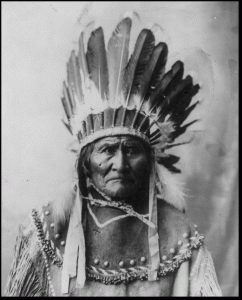‘Why is Geronimo on the cover of your book? What’s he got to do with being a singer-songwriter?’
I was asked these questions recently by a BBC film maker when discussing ideas for making a short documentary. ‘Shouldn’t the illustration give potential customers an idea of what’s inside,’ she said, pointedly.
‘Well,’I hesitated, ‘do you read books?’
‘Not much,’ she admitted. ‘But I look at lots of emails and tweets.’
Now I could see why she had a problem with the picture (and would no doubt have preferred a celeb’s mug shot, preferably drunk and half dressed). Unlike me she obviously didn’t waste hours in book shops and libraries, allowing curiosity to get the better of her. For me, and any true reader (I thought), the contrast of a title like, THE SINGER-SONGWRITER’S LAST STAND against the picture of a long dead Apache war chief holding a guitar, would be enough to arouse interest. But, it seemed, not for her. And, maybe not for many others; eyes glued to screens all day and night and whose only knowledge of books was when they got made into films.
‘Hey Geronimo!’ in fact, was the title of a flop single put out by the hero of my book, struggling young musician Alwyn Stevens. The story, based on my own and others experiences in the music world, is set in the Sixties and present day. Arthur Grimsby, the other main character, is a kind of beatnik Svengali, who lures innocent Al away from the suburban mainstream into a meandering life of musical crime. The ‘last stand’, by the way, may not only be Geronimo’s but also the novel’s main players – and possibly signals the end of the line for many old style singer-songwriter’s. Let’s face it, successful composers don’t need to play an instrument now any more than author’s need to write – technology (or ghost writers) can do all those arduous time-wasting things while more important jobs like promotion and selling can be got on with.

